MERCEDES-BENZ E-CLASS COUPE 2018 Owner's Guide
Manufacturer: MERCEDES-BENZ, Model Year: 2018, Model line: E-CLASS COUPE, Model: MERCEDES-BENZ E-CLASS COUPE 2018Pages: 486, PDF Size: 6.31 MB
Page 31 of 486
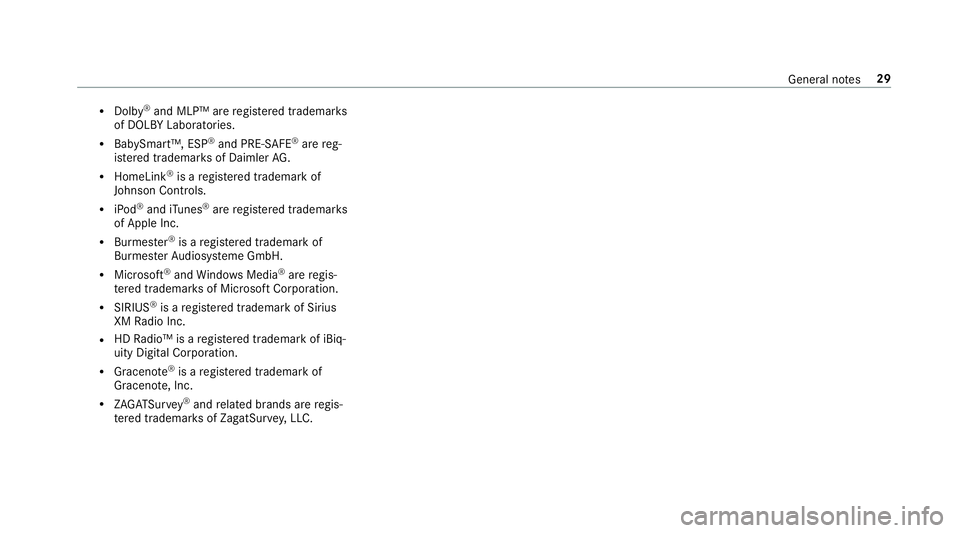
RDolby®and MLP™ areregis tere d trademar ks
of DOLBY Laboratories.
RBabySmart™, ESP®and PRE-SAFE®are reg‐
is te re d trademar ksof Daimler AG.
RHomeLink®is a regis tere d trademark of
Johnson Contro ls.
RiPod®andiTunes®are regis tere d trademar ks
of Apple Inc.
RBurmes ter®is a regis tere d trademark of
Burmes terAu diosy steme GmbH.
RMicrosoft®and Windo wsMedia®are regis‐
te re d trademar ksof Microsoft Corporation.
RSIRIUS®is a regis tere d trademark of Sirius
XM Radio Inc.
RHD Radio™ is a regis tere d trademark of iBiq‐
uity Digital Corporation.
RGraceno te®is aregis tere d trademark of
Graceno te, Inc.
RZAGA TSurve y®and related brands are regis‐
te re d trademar ksof ZagatSur vey, LLC.
General no tes 29
Page 32 of 486
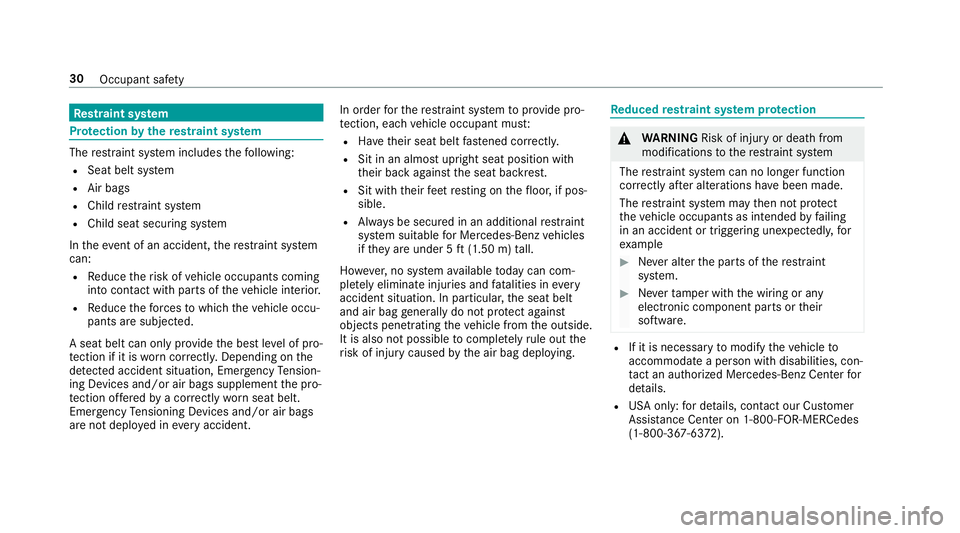
Restra int sy stem
Pr otection bythere stra int sy stem
The restra int sy stem includes thefo llowing:
RSeat belt sy stem
RAir bags
RChild restra int sy stem
RChild seat securing sy stem
In theev ent of an accident, there stra int sy stem
can:
RRe duce therisk of vehicle occupants coming
into contact with parts of theve hicle interior.
RRe duce thefo rc es towhich theve hicle occu‐
pants are subjected.
A seat belt can only pr ovide the best le vel of pro‐
te ction if it is worncor rectl y.Depending on the
de tected accident situation, Emergency Tension‐
ing Devices and/or air bags supplement the pro‐
te ction of fere dby a cor rectly wornseat belt.
Emer gency Tensioning Devices and/or air bags
are not depl oyed in everyaccident. In order
forth ere stra int sy stem toprov ide pro‐
te ction, each vehicle occupant mus t:
RHave their seat belt fastened cor rectly.
RSit in an almost up right seat position with
th eir back against the seat backrest.
RSit with their feet resting on thefloor, if pos‐
sible.
RAlw ays be secured in an additional restra int
sy stem suitable for Mercedes-Benz vehicles
if th ey are under 5 ft(1.50 m) tall.
Ho wever,no sy stem available today can com‐
ple tely eliminate injuries and fata lities in every
accident situation. In particular, the seat belt
and air bag gener all
y do not pr
otect against
objects penetrating theve hicle from the outside.
It is also not possible tocomplet elyrule out the
ri sk of injury caused bythe air bag deploying.
Re duced restra int sy stem pr otection
&
WARNING Risk of injury or death from
modifications tothere stra int sy stem
The restra int sy stem can no longer function
cor rectly af ter alterations ha vebeen made.
The restra int sy stem may then not pr otect
th eve hicle occupants as intended byfailing
in an accident or triggering unexpec tedly, for
ex ample
#Ne ver alter the parts of there stra int
sy stem.
#Ne verta mp er with the wiring or any
electronic component parts or their
software.
RIf it is necessary tomodify theve hicle to
accommodate a person with disabilities, con‐
ta ct an au thorized Mercedes-Benz Center for
de tails.
RUSA only: for de tails, con tact our Cu stomer
Assis tance Center on 1-800-FOR-MERCedes
(1‑800‑367‑63 72).
30
Occupant saf ety
Page 33 of 486
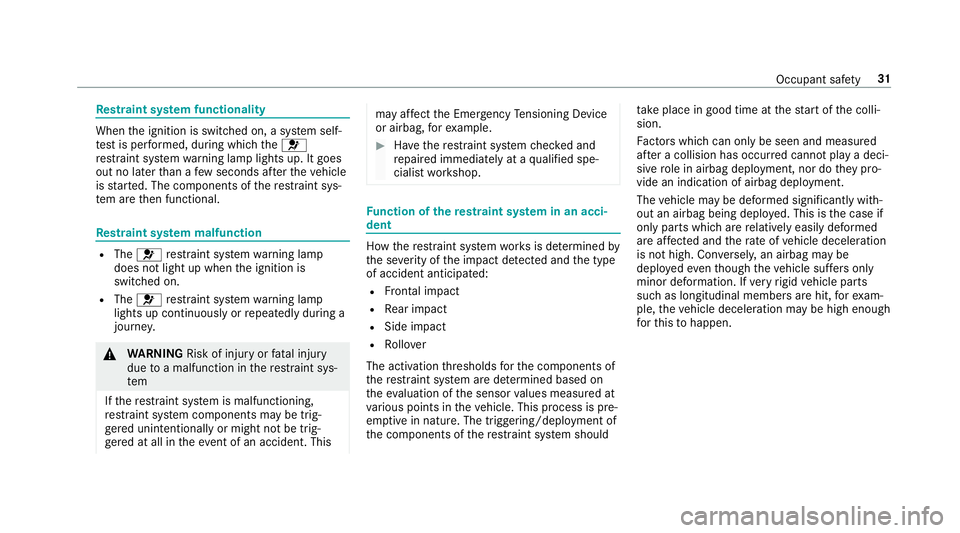
Restra int sy stem functionality
When the ignition is switched on, a sy stem self-
te st is per form ed, during which the6
re stra int sy stem warning lamp lights up. It goes
out no later than a few seconds af terth eve hicle
is star ted. The components of there stra int sys‐
te m are then functional.
Re stra int sy stem malfunction
RThe 6 restra int sy stem warning lamp
does not light up when the ignition is
switched on.
RThe 6 restra int sy stem warning lamp
lights up continuously or repeatedly during a
journe y.
&
WARNING Risk of injury orfata l injury
due toa malfunction in there stra int sys‐
te m
If th ere stra int sy stem is malfunctioning,
re stra int sy stem components may be trig‐
ge red unintentionally or might not be trig‐
ge red at all in theev ent of an accident. This
may af fect the Emer gency Tensioning Device
or airbag, forex ample.
#Ha ve there stra int sy stem checked and
re paired immediately at a qualified spe‐
cialist workshop.
Fu nction of there stra int sy stem in an acci‐
dent
How there stra int sy stem works is de term ined by
th e se verity of the impact de tected and the type
of accident anticipated:
RFr ontal impact
RRe ar impact
RSide impact
RRo llover
The activation thre sholds forth e components of
th ere stra int sy stem are de term ined based on
th eev aluation of the sensor values measured at
va rious points in theve hicle. This process is pre-
em ptive in nature. The triggering/deployment of
th e components of there stra int sy stem should ta
ke place in good time at thest art of the colli‐
sion.
Fa ctors whi chcan only be seen and measure d
af te r a collision has occur red cann otplay a deci‐
sive role in airbag deployment, nor do they pro‐
vide an indication of airbag deployment.
The vehicle may be deformed significantly with‐
out an airbag being deplo yed. This is the case if
only parts which are relatively easily deformed
are af fected and thera te ofvehicle deceleration
is not high. Con versely, an airbag may be
deplo yedev en though theve hicle suf fers only
minor deformation. If very rigid vehicle parts
such as longitudinal members are hit, forex am‐
ple, theve hicle deceleration may be high enough
fo rth is to happen.
Occupant saf ety 31
Page 34 of 486
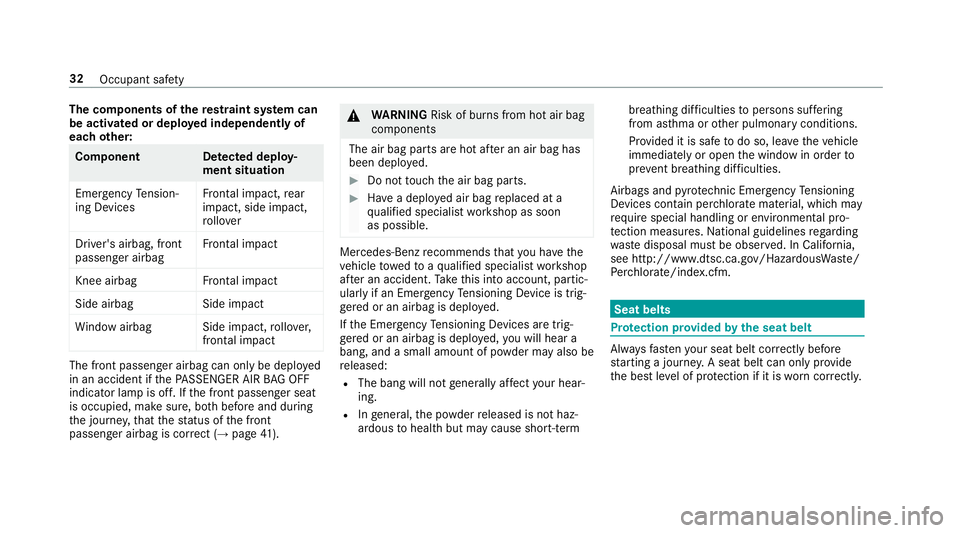
The components of there stra int sy stem can
be activated or deplo yed independently of
each other:
Component De tected deploy‐
ment situation
Emer gency Tension‐
ing Devices Fr
ontal impact, rear
impact, side impact,
ro llo ver
Driver's airbag, front
passenger airbag Fr
ontal impact
Knee airbag Frontal impact
Side airbag Side impact
Wi ndow airba gS ide impact,rollo ver,
frontal impact
The front passenger airbag can only be deploy ed
in an accident if thePA SSENGER AIR BAG OFF
indicator lamp is off. If the front passenger seat
is occupied, make sure, bo thbefore and during
th e journe y,that thest atus of the front
passenger airbag is cor rect (
→page 41).
&
WARNING Risk of burn s from hot air bag
components
The air bag parts are hot af ter an air bag has
been deploy ed.
#Do nottouch the air bag parts.
#Ha ve a deplo yed air bag replaced at a
qu alified specialist workshop as soon
as possible.
Mercedes-Benz recommends that you ha vethe
ve hicle towe dto aqu alified specialist workshop
af te r an accident. Take this into account, partic‐
ularly if an Emer gency Tensioning Device is trig‐
ge red or an airbag is deplo yed.
If th e Emer gency Tensioning Devices are trig‐
ge red or an airbag is deplo yed, youwill hear a
bang, and a small amount of powder may also be
re leased:
RThe bang will not generally af fect your hear‐
ing.
RIn general, the powder released is not haz‐
ardous tohealth but may cause short-term breathing dif
ficulties topersons suf fering
from as thma or other pulmonary conditions.
Pr ov ided it is safe todo so, lea vetheve hicle
immediately or open the window in order to
pr eve nt brea thing dif ficulties.
Airbags and pyrotech nic Emergency Tensioning
Devices contain pe rchlorate material, which may
re qu ire special handling or environmental pro‐
te ction measure s.Na tional guidelines rega rding
wa ste disposal must be obser ved. In California,
see http://www.dtsc.ca.gov/HazardousWas te/
Pe rchlorate/index.cfm.
Seat belts
Pr otection pr ovided bythe seat belt
Alw aysfast enyour seat belt co rrectly before
st arting a journe y.A seat belt can only pr ovide
th e best le vel of pr otection if it is worncor rectl y.
32
Occupant saf ety
Page 35 of 486
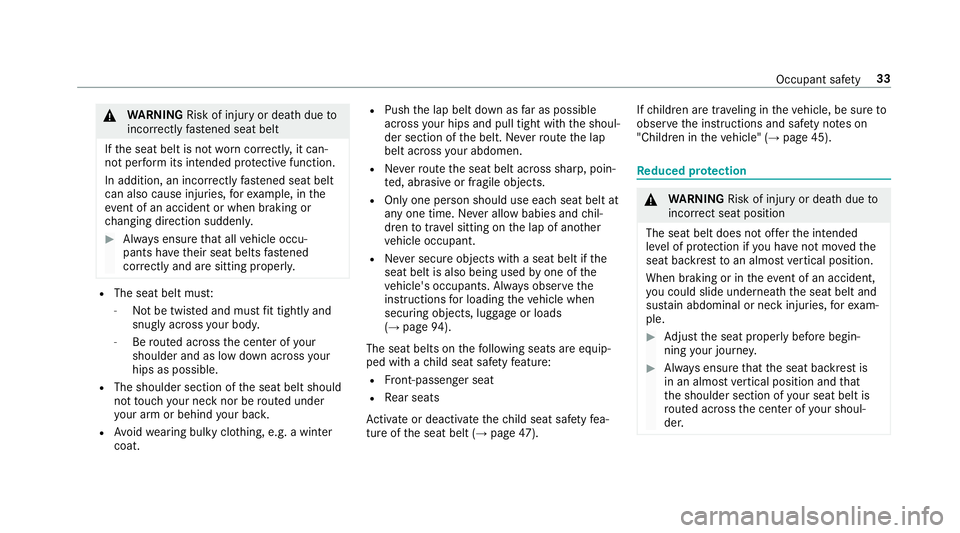
&WARNING Risk of injury or death dueto
incor rectly fastened seat belt
If th e seat belt is not worncor rectly, it can‐
not per form its intended pr otective function.
In addition, an incor rectly fastened seat belt
can also cause injuries, forex ample, in the
ev ent of an accident or when braking or
ch anging direction suddenly .
#Always ensure that all vehicle occu‐
pants ha vetheir seat belts fastened
cor rectly and are sitting prope rly.
RThe seat belt mus t:
-Not be twisted and must fit tightly and
snugl yacross your body .
-Berouted across the center of your
shoulder and as low down across your
hips as possible.
RThe shoulder section of the seat belt should
not touch your ne cknor be routed under
yo ur arm or behind your bac k.
RAvoid wearing bulky clo thing, e.g. a winter
coat.
RPush the lap belt down as far as possible
across your hips and pull tight withth e shoul‐
der section of the belt. Ne verro ute the lap
belt across your abdomen.
RNe verro ute the seat belt across sharp, poin‐
te d, abrasive or fragile objects.
ROnly one person should use each seat belt at
any one time. Ne ver all owbabies and chil‐
dren totrave l sitting on the lap of ano ther
ve hicle occupant.
RNe ver secure objects with a seat belt if the
seat belt is also being used byone of the
ve hicle's occupants. Alw ays obser vethe
instructions for loading theve hicle when
securing objects, luggage or loads
(
→page 94).
The seat belts on thefo llowing seats are equip‐
ped with a child seat saf etyfe ature:
RFr ont-passenger seat
RRe ar seats
Ac tivate or deacti vate thech ild seat saf etyfe a‐
ture of the seat belt (
→page 47). If
ch ildren are tra veling in theve hicle, be sure to
obser vethe instructions and saf
etyno tes on
"Children in theve hicle" (
→page 45).
Re duced pr otection
&
WARNING Risk of injury or death dueto
incor rect seat position
The seat belt does not of ferth e intended
le ve l of pr otection if you ha venot mo vedth e
seat backrest toan almost vertical position.
When braking or in theeve nt of an accident,
yo u could slide underneath the seat belt and
sus tain abdominal or neck injuries, forex am‐
ple.
#Ad just the seat proper lybefore begin‐
ning your journe y.
#Always ensure that the seat backrest is
in an almost vertical position and that
th e shoulder section of your seat belt is
ro uted across the center of your shoul‐
der.
Occupant saf ety 33
Page 36 of 486

&WARNING Risk of injury or death dueto
an extended seat belt extender while the
ve hicle is in motion
If th e seat belt extender is extended while
th eve hicle is in motion, the seat belt will not
fi t cor rectly tothe body.
The seat belt may not then pr ovide the
proper pr otection.
#Alw ays ensure that the seat belt
ex tender is retracted while theve hicle
is in motion.
If th e seat belt extender does not retract au to‐
matically, it can be retracted manually. Todo so,
press the seat belt extender ba ckasfar as it will
go before starting theve hicle. Pressing the seat
belt extender ba ckinto place requ ires forc e.
&
WARNING Risk of injury or death when
additional restra int sy stems are not used
fo r persons with a smaller build
Pe rsons under 5 ft(1.50 m ) tall cannot wear
th e seat belt cor rectly wi thout a suitable
additional restra int sy stem.
If th e seat belt is not worncor rectly, it can‐
not per form its intended pr otective function.
In addition, an incor rectly fastened seat belt
can also cause injuries, forex ample, in the
ev ent of an accident or when braking or
ch anging direction suddenly .
#Always secure persons under 5 ft
(1.50 m) tall in a suitable restra int sys‐
te m.
&
WARNING Danger of injury or death
from bloc ked seat belt buckles
If seat belt buckles are bloc ked and cann ot
be mo ved down wards, the function of the
Emergency Tensioning Devices is impaire d.
The Emer gency Tensioning Devices can no
longer function as intended and the seat
belts can no longer pr ovide the intended pro‐
te ction.
#Alw ays ensure that the seat belt buck‐
les are not bloc ked.
&
WARNING Risk of injury or death dueto
damaged or modified seat belts
Seat belts cann otprov ide pr otection in the
fo llowing situations:
RIf th e seat belts are damaged, modified,
ex treme lydirty, bleached or dyed
RIfth e seat belt buckle is damaged or
ex treme lydirty
RIfth e Emer gency Tensioning Devices,
seat belt anchorages or seat belt retrac‐
to rs have been modified
Seat belts may be damaged in an accident,
although the damage may not be visible, e.g.
due tosplinters of glass.
Modified or damaged seat belts may tear or
fa il, e.g. in an accident.
Modified Emer gency Tensioning Devices can
accidental lytrig ger or failto function as
intended.
#Ne ver modify the seat belts, Emer gency
Te nsioning Devices, seat belt ancho‐
ra ge s or seat belt retractors.
34
Occupant saf ety
Page 37 of 486
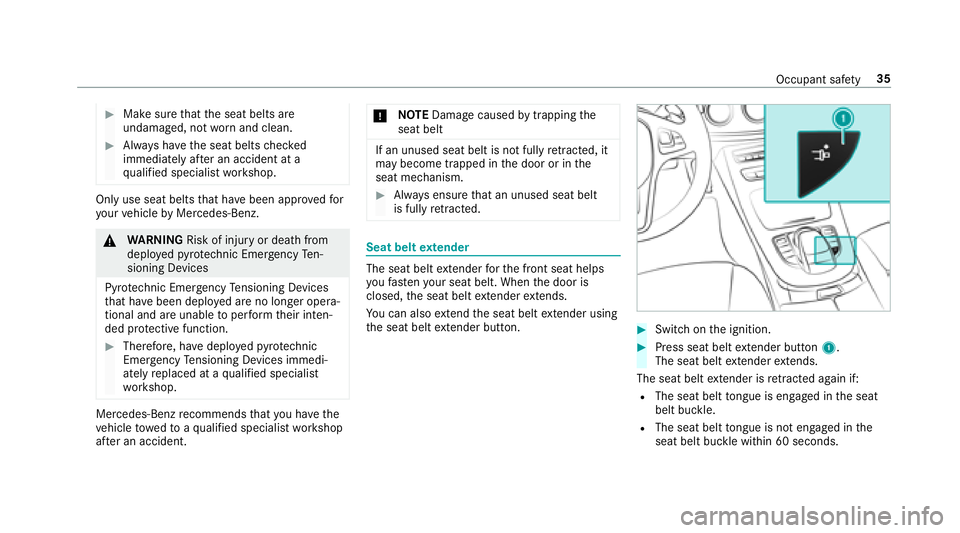
#Make surethat the seat belts are
undamaged, not wornand clean.
#Alw ays ha vethe seat belts checked
immediately af ter an accident at a
qu alified specialist workshop.
Only use seat belts that ha vebeen appr ovedfo r
yo ur vehicle byMercedes-Benz.
&
WARNING Risk of injury or death from
deplo yedpy rotech nic Emergency Ten‐
sioning Devices
Pyro tech nic Emergency Tensioning Devices
th at ha vebeen deplo yed are no longer opera‐
tional and are unable toper form their inten‐
ded pr otective function.
#Therefore, ha vedeplo yedpy rotech nic
Emergency Tensioning Devices immedi‐
ately replaced at a qualified specialist
wo rkshop.
Mercedes-Benz recommends that you ha vethe
ve hicle towe dto aqu alified specialist workshop
af te r an accident. *
NO
TEDama gecaused bytrapping the
seat belt
If an unused seat belt is not fully retracted, it
may become trapped in the door or in the
seat mechanism.
#Alw ays ensure that an unused seat belt
is fully retracted.
Seat belt extender
The seat belt extender forth e front seat helps
yo ufa sten your seat belt. When the door is
closed, the seat belt extender extends.
Yo u can also extend the seat belt extender using
th e seat belt extender button.
#Switch on the ignition.
#Press seat belt extender button 1.
The seat belt extender extends.
The seat belt extender is retracted again if:
RThe seat belt tongue is engaged in the seat
belt buckle.
RThe seat belt tongue is not engaged in the
seat belt buckle within 60 seconds.
Occupant saf ety 35
Page 38 of 486
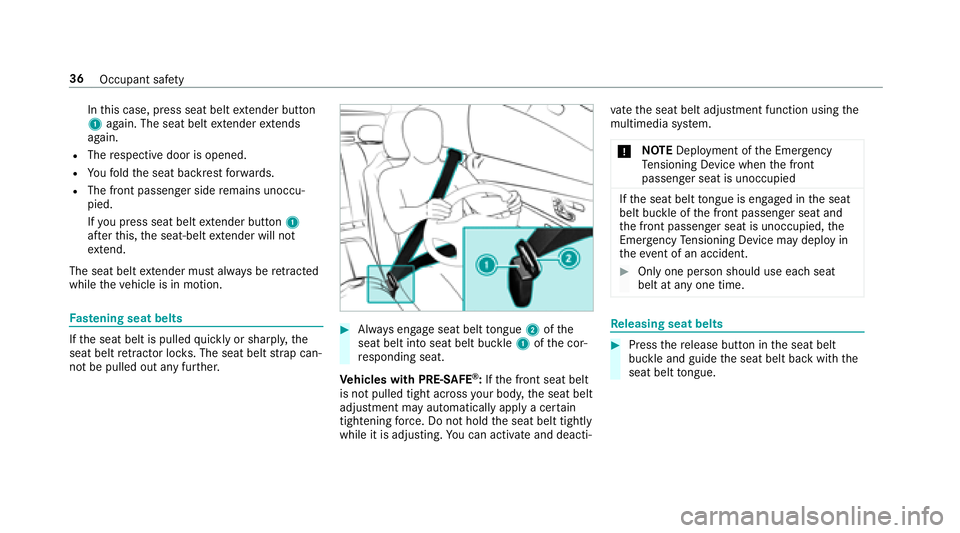
Inthis case, press seat belt extender button
1 again. The seat belt extender extends
again.
RThe respective door is opened.
RYo ufo ld the seat backrest forw ards.
RThe front passenger side remains unoccu‐
pied.
If yo upr ess seat beltextender button 1
af te rth is, the seat-belt extender will not
ex tend.
The seat belt extender must always be retracted
while theve hicle is in motion.
Fa stening seat belts
Ifth e seat belt is pulled quickly or sharply, the
seat belt retractor lo cks. The seat belt stra p can‐
not be pulled out any fur ther.#Alw ays engage seat belt tongue 2ofthe
seat belt into seat belt buckle 1ofthe cor‐
re sponding seat.
Ve hicles with PRE-SAFE
®:If th e front seat belt
is not pulled tight across your body, the seat belt
adjustment may automatically apply a cer tain
tigh tening forc e. Do not hold the seat belt tightly
while it is adjusting. You can activate and deacti‐ va
te the seat belt adjustment function using the
multimedia sy stem.
* NO
TEDeployment of the Emer gency
Te nsioning Device when the front
passenger seat is unoccupied
If th e seat belt tongue is engaged in the seat
belt buckle of the front passenger seat and
th e front passenger seat is unoccupied, the
Emergency Tensioning Device may depl oyin
th eev ent of an accident.
#Only one person should use each seat
belt at any one time.
Re leasing seat belts
#Press there lease button in the seat belt
buckle and guide the seat belt back with the
seat belt tongue.
36
Occupant safe ty
Page 39 of 486
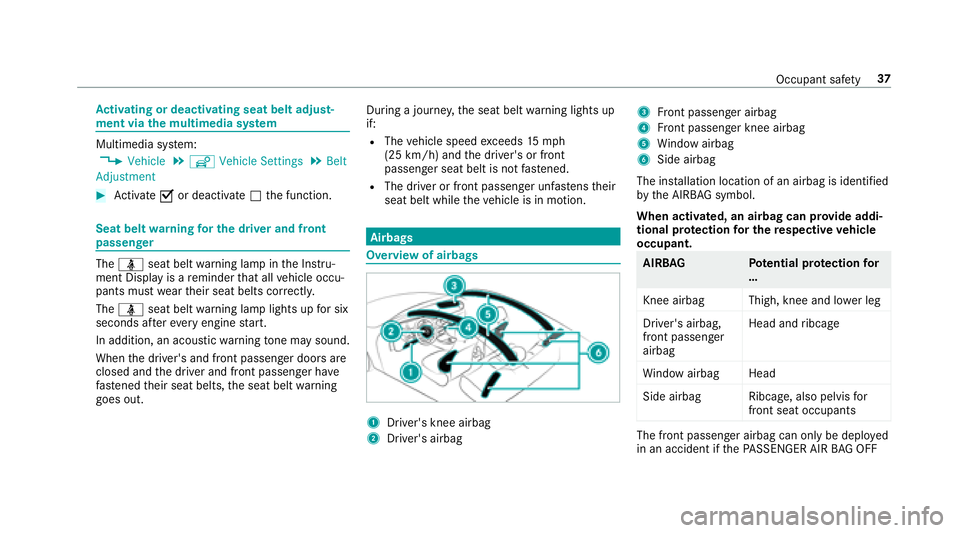
Activating or deactivating seat belt adjust‐
ment via the multimedia sy stem
Multimedia sy stem:
,�9�H�K�L�F�O�H.î �9�H�K�L�F�O�H �6�H�W�W�L�Q�J�V.�%�H�O�W
�$�G�M�X�V�W�P�H�Q�W
#Ac tivate Oor deacti vate ª the function.
Seat belt warning for the driver and front
passen ger
The ü seat belt warning lamp in the Instru‐
ment Display is a reminder that all vehicle occu‐
pants must weartheir seat belts cor rectly.
The ü seat belt warning lamp lights up for six
seconds af tereve ryengine start.
In addition, an acoustic warning tone may sound.
When the driver's and front passenger doors are
closed and the driver and front passenger ha ve
fast ened their seat belts, the seat belt warning
goes out. During a journe
y,the seat belt warning lights up
if:
RThe vehicle speed exceeds 15mp h
(25 km/h) and the driver's or front
passenger seat belt is not fastened.
RThe driver or front passenger unfas tens their
seat belt while theve hicle is in motion.
Airbags
Overview of airbags
1Driver's knee airbag
2Driver's airbag
3Front passenger airbag
4Front passenger knee airbag
5Wi ndow airbag
6Side airbag
The ins tallation location of an airbag is identified
by the AIRB AGsymbol.
When activated, an airbag can pr ovide addi‐
tional pr otection for the respective vehicle
occupant.
AIRB AG Potential pr otection for
…
Knee airbag Thigh, knee and lo wer leg
Driver's airbag,
front passenger
airbag Head and
ribcage
Wi ndow airba gHead
Side airbag Ribcage, also pelvis for
front seat occupants
The front passenger airbag can only be deploy ed
in an accident if thePA SSENGER AIR BAG OFF
Occupant saf ety 37
Page 40 of 486
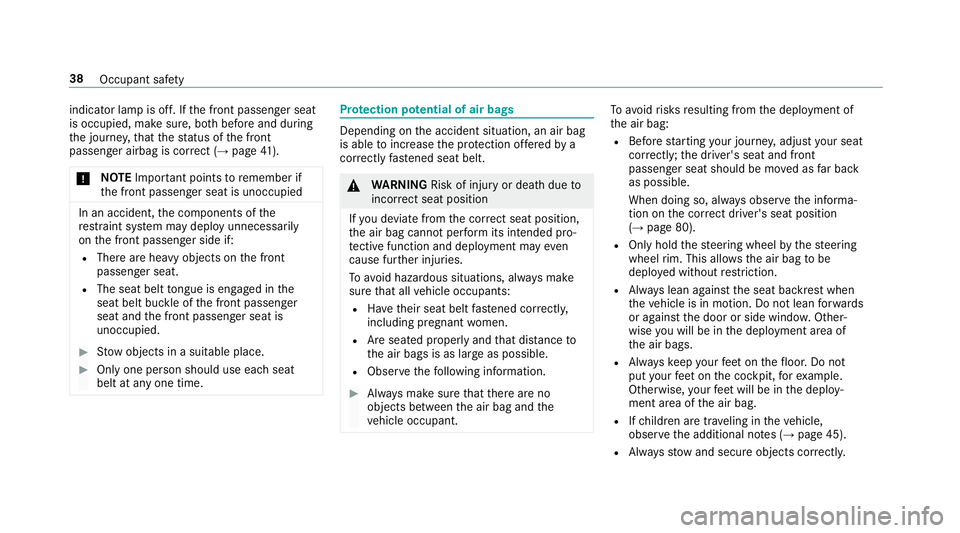
indicator lamp is off. Ifthe front passenger seat
is occupied, make sure, bo thbefore and during
th e journe y,that thest atus of the front
passenger airbag is cor rect (
→page 41).
* NO
TEImpo rtant points toremember if
th e front passenger seat is unoccupied
In an accident, the components of the
re stra int sy stem may deploy unnecessarily
on the front passenger side if:
RThere are heavy objects on the front
passenger seat.
RThe seat belt tongue is engaged in the
seat belt buckle of the front passenger
seat and the front passenger seat is
unoccupied.
#St ow objects in a suitable place.
#Only one person should use each seat
belt at any one time.
Protection po tential of air bags
Depending on the accident situation, an air bag
is able toinc rease the pr otection of fere dby a
cor rectly fastened seat belt.
&
WARNING Risk of injury or death dueto
incor rect seat position
If yo u deviate from the cor rect seat position,
th e air bag cannot perform its intended pro‐
te ctive function and deployment may even
cause fur ther injuries.
To avo id hazardous situations, alw ays make
sure that all vehicle occupants:
RHa ve their seat belt fastened cor rectly,
including pregnant women.
RAre seated properly and that dis tance to
th e air bags is as large as possible.
RObser vethefo llowing information.
#Alw ays make sure that there are no
objects between the air bag and the
ve hicle occupant.
To avo idrisks resulting from the deployment of
th e air bag:
RBefore starting your journe y,adjust your seat
co rrectly ;th e driver's seat and front
passenger seat should be mo ved as far back
as possible.
When doing so, alw ays obser vethe informa‐
tion on the cor rect driver's seat position
(
→page 80).
ROnly hold thesteering wheel bythesteering
wheel rim. This all owsth e air bag tobe
deplo yed without restriction.
RAlw ays lean against the seat backrest when
th eve hicle is in motion. Do not lean forw ards
or against the door or side windo w.Other‐
wise you will be in the deployment area of
th e air bags.
RAlw ayske ep your feet on thefloor. Do not
put your feet on the cockpit, forex ample.
Otherwise, your feet will be in the deploy‐
ment area of the air bag.
RIfch ildren are tr aveling in theve hicle,
obser vethe additional no tes (→page 45).
RAlw aysstow and secure objects cor rectl y.
38
Occupant saf ety